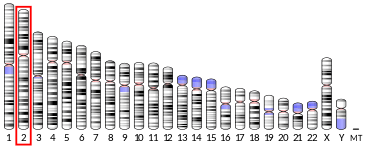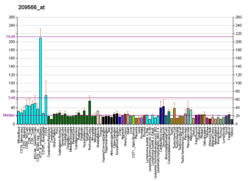INSIG2
Insulin induced gene 2, also known as INSIG2, is a protein which in humans is encoded by the INSIG2 gene.[5][6]
Regulation
Insulin activates the human INSIG2 promoter in a process mediated by phosphorylated SAP1a.[7]
Akt mediates suppression of Insig2a, a liver-specific transcript encoding the SREBP1c inhibitor INSIG2.[8]
MCHR2 has been observed to significantly decrease INSIG2.[9]
Insig2 is upregulated under hypoxic conditions and is associated with the malignant potential of pancreatic cancer.[10]
A novel 1alpha,25-dihydroxyvitamin D3 [1,25-(OH)2D3] response element in the promoter region of Insig-2 gene was identified which specifically binds to the heterodimer of retinoid X receptor and vitamin D receptor (VDR) and directs VDR-mediated transcriptional activation in a 1,25-(OH)2D3-dependent manner. 1,25-(OH)2D3 transiently but strongly induces Insig-2 expression in 3T3-L1 cells. This novel regulatory circuit may also play important roles in other lipogenic cell types that express VDR.[11]
Function
The protein encoded by this gene is highly similar to the protein product encoded by gene INSIG1. Both INSIG1 protein and this protein are endoplasmic reticulum proteins that block the processing of sterol regulatory element binding proteins (SREBPs) by binding to SREBP cleavage-activating protein (SCAP), and thus prevent SCAP from escorting SREBPs to the Golgi.[6]
Clinical Significance
Insig deficiency in mice caused a marked buildup of cholesterol precursors in skin associated with a marked increase in 3-hydroxy-3-methylglutaryl coenzyme A reductase protein and hair and skin defects corrected by topical simvastatin, an inhibitor of reductase.[12]
REV-ERBalpha participates in the circadian modulation of sterol regulatory element-binding protein (SREBP) activity, and thereby in the daily expression of SREBP target genes involved in cholesterol and lipid metabolism. This control is exerted via the cyclic transcription of Insig2, encoding a trans-membrane protein that sequesters SREBP proteins to the endoplasmic reticulum membranes and thereby interferes with the proteolytic activation of SREBPs in Golgi membranes. REV-ERBalpha also participates in the cyclic expression of cholesterol-7alpha-hydroxylase (CYP7A1), the rate-limiting enzyme in converting cholesterol to bile acids. Findings suggest that this control acts via the stimulation of LXR nuclear receptors by cyclically produced oxysterols such that rhythmic cholesterol and bile acid metabolism is not just driven by alternating feeding-fasting cycles, but also by REV-ERBalpha, a component of the circadian clockwork circuitry.[13]
Silibinin inhibits adipocyte differentiation through a potential up-regulation of insig-1 and insig-2 at an early phase in adipocyte differentiation.[14]
The triacylglycerol reducing effect of fibrates and thiazolidinediones, strong and selective agonists of PPARalpha and PPARgamma, is partially caused by inhibition of SREBP-1 activation via up-regulation of Insig.[15]
Findings suggest that Insig2 is a novel colon cancer biomarker. Over-expression of Insig2 appeared to suppress chemotherapeutic drug treatment-induced Bcl2 associated X protein (Bax) expression and activation. Insig2 was also found to localize to the mitochondria/heavy membrane fraction and associate with conformationally changed Bax. Moreover, Insig2 altered the expression of several additional apoptosis genes located in mitochondria.[16] In a study by Kumar et al., the common polymorphisms in INSIG2 gene was not found to be significant in Indian population.[17]
References
- GRCh38: Ensembl release 89: ENSG00000125629 - Ensembl, May 2017
- GRCm38: Ensembl release 89: ENSMUSG00000003721 - Ensembl, May 2017
- "Human PubMed Reference:". National Center for Biotechnology Information, U.S. National Library of Medicine.
- "Mouse PubMed Reference:". National Center for Biotechnology Information, U.S. National Library of Medicine.
- Yabe D, Brown MS, Goldstein JL (October 2002). "Insig-2, a second endoplasmic reticulum protein that binds SCAP and blocks export of sterol regulatory element-binding proteins". Proceedings of the National Academy of Sciences of the United States of America. 99 (20): 12753–8. doi:10.1073/pnas.162488899. PMC 130532. PMID 12242332.
- "Entrez Gene: INSIG2 insulin induced gene 2".
- Fernández-Alvarez A, Soledad Alvarez M, Cucarella C, Casado M (April 2010). "Characterization of the human insulin-induced gene 2 (INSIG2) promoter: the role of Ets-binding motifs". J. Biol. Chem. 285 (16): 11765–74. doi:10.1074/jbc.M109.067447. PMC 2852912. PMID 20145255.
- Yecies JL, Zhang HH, Menon S, et al. (July 2011). "Akt stimulates hepatic SREBP1c and lipogenesis through parallel mTORC1-dependent and independent pathways". Cell Metab. 14 (1): 21–32. doi:10.1016/j.cmet.2011.06.002. PMC 3652544. PMID 21723501.
- Zhang Q, Yuan CF, Wu MJ, et al. (June 2010). "Comparative proteomic analysis of proteins influenced by melanin-concentrating hormone and melanin-concentrating hormone receptor 2 interaction". Horm. Metab. Res. 42 (7): 521–7. doi:10.1055/s-0030-1249019. PMID 20340065.
- Tribulová N, Slezák J, Ravingerová T, Ziegelhöffer A (1990). "Transmural non-homogeneity of calcium-induced heart injury". Physiol Bohemoslov. 39 (2): 147–50. PMID 2144354.
- Lee S, Lee DK, Choi E, Lee JW (February 2005). "Identification of a functional vitamin D response element in the murine Insig-2 promoter and its potential role in the differentiation of 3T3-L1 preadipocytes". Mol. Endocrinol. 19 (2): 399–408. doi:10.1210/me.2004-0324. PMID 15528275.
- Evers BM, Farooqi MS, Shelton JM, et al. (May 2010). "Hair Growth Defects in Insig-Deficient Mice Caused by Cholesterol Precursor Accumulation and Reversed by Simvastatin". J Invest Dermatol. 130 (5): 1237–48. doi:10.1038/jid.2009.442. PMC 2929004. PMID 20090767.
- Le Martelot G, Claudel T, Gatfield D, et al. (September 2009). "REV-ERBalpha participates in circadian SREBP signaling and bile acid homeostasis". PLoS Biol. 7 (9): e1000181. doi:10.1371/journal.pbio.1000181. PMC 2726950. PMID 19721697.
- Ka SO, Kim KA, Kwon KB, Park JW, Park BH (May 2009). "Silibinin attenuates adipogenesis in 3T3-L1 preadipocytes through a potential upregulation of the insig pathway". Int. J. Mol. Med. 23 (5): 633–7. doi:10.3892/ijmm_00000174. PMID 19360322.
- König B, Koch A, Spielmann J, et al. (March 2009). "Activation of PPARalpha and PPARgamma reduces triacylglycerol synthesis in rat hepatoma cells by reduction of nuclear SREBP-1". Eur. J. Pharmacol. 605 (1–3): 23–30. doi:10.1016/j.ejphar.2009.01.009. PMID 19248225.
- Li CG, Gruidl M, Eschrich S, et al. (July 2008). "Insig2 is associated with colon tumorigenesis and inhibits Bax-mediated apoptosis". Int. J. Cancer. 123 (2): 273–82. doi:10.1002/ijc.23510. PMC 2650850. PMID 18464289.
- Kumar J, Sunkishala RR, Karthikeyan G, Sengupta S (May 2007). "The common genetic variant upstream of INSIG2 gene is not associated with obesity in Indian population". Clin Genet. 71 (5): 415–8. doi:10.1111/j.1399-0004.2007.00795.x. PMID 17489846.
Further reading
- Yabe D, Brown MS, Goldstein JL (2002). "Insig-2, a second endoplasmic reticulum protein that binds SCAP and blocks export of sterol regulatory element-binding proteins". Proc. Natl. Acad. Sci. U.S.A. 99 (20): 12753–8. doi:10.1073/pnas.162488899. PMC 130532. PMID 12242332.
- Strausberg RL, Feingold EA, Grouse LH, et al. (2003). "Generation and initial analysis of more than 15,000 full-length human and mouse cDNA sequences". Proc. Natl. Acad. Sci. U.S.A. 99 (26): 16899–903. doi:10.1073/pnas.242603899. PMC 139241. PMID 12477932.
- Yabe D, Xia ZP, Adams CM, Rawson RB (2003). "Three mutations in sterol-sensing domain of SCAP block interaction with insig and render SREBP cleavage insensitive to sterols". Proc. Natl. Acad. Sci. U.S.A. 99 (26): 16672–7. doi:10.1073/pnas.262669399. PMC 139202. PMID 12482938.
- Yabe D, Komuro R, Liang G, et al. (2003). "Liver-specific mRNA for Insig-2 down-regulated by insulin: implications for fatty acid synthesis". Proc. Natl. Acad. Sci. U.S.A. 100 (6): 3155–60. doi:10.1073/pnas.0130116100. PMC 152262. PMID 12624180.
- Dobrosotskaya IY, Goldstein JL, Brown MS, Rawson RB (2003). "Reconstitution of sterol-regulated endoplasmic reticulum-to-Golgi transport of SREBP-2 in insect cells by co-expression of mammalian SCAP and Insigs". J. Biol. Chem. 278 (37): 35837–43. doi:10.1074/jbc.M306476200. PMID 12842885.
- Ota T, Suzuki Y, Nishikawa T, et al. (2004). "Complete sequencing and characterization of 21,243 full-length human cDNAs". Nat. Genet. 36 (1): 40–5. doi:10.1038/ng1285. PMID 14702039.
- Lee JN, Gong Y, Zhang X, Ye J (2006). "Proteasomal degradation of ubiquitinated Insig proteins is determined by serine residues flanking ubiquitinated lysines". Proc. Natl. Acad. Sci. U.S.A. 103 (13): 4958–63. doi:10.1073/pnas.0600422103. PMC 1405624. PMID 16549805.
- Gong Y, Lee JN, Brown MS, et al. (2006). "Juxtamembranous aspartic acid in Insig-1 and Insig-2 is required for cholesterol homeostasis". Proc. Natl. Acad. Sci. U.S.A. 103 (16): 6154–9. doi:10.1073/pnas.0601923103. PMC 1435366. PMID 16606821.
- Radhakrishnan A, Ikeda Y, Kwon HJ, et al. (2007). "Sterol-regulated transport of SREBPs from endoplasmic reticulum to Golgi: oxysterols block transport by binding to Insig". Proc. Natl. Acad. Sci. U.S.A. 104 (16): 6511–8. doi:10.1073/pnas.0700899104. PMC 1851665. PMID 17428920.
- Lyon HN, Emilsson V, Hinney A, et al. (2007). "The association of a SNP upstream of INSIG2 with body mass index is reproduced in several but not all cohorts". PLoS Genet. 3 (4): e61. doi:10.1371/journal.pgen.0030061. PMC 1857727. PMID 17465681.
- Kumar J, Sunkishala RR, Karthikeyan G, Sengupta S (2007). "The common genetic variant upstream of INSIG2 gene is not associated with obesity in Indian population". Clin. Genet. 71 (5): 415–8. doi:10.1111/j.1399-0004.2007.00795.x. PMID 17489846.




